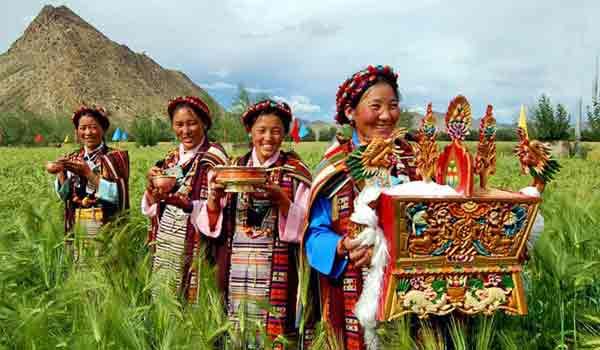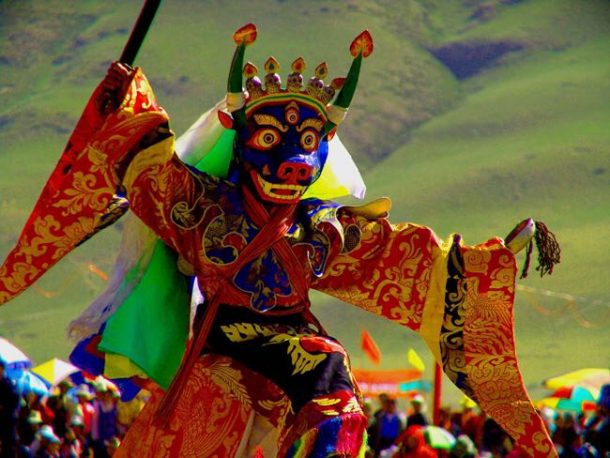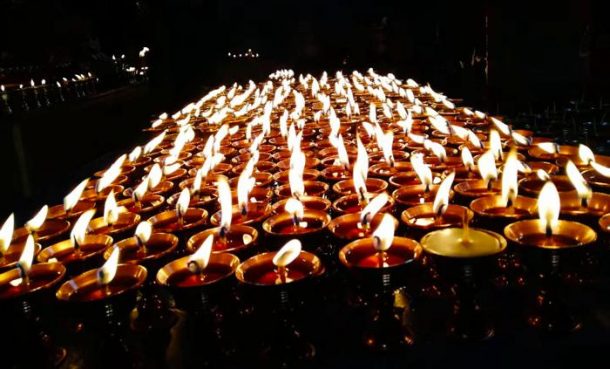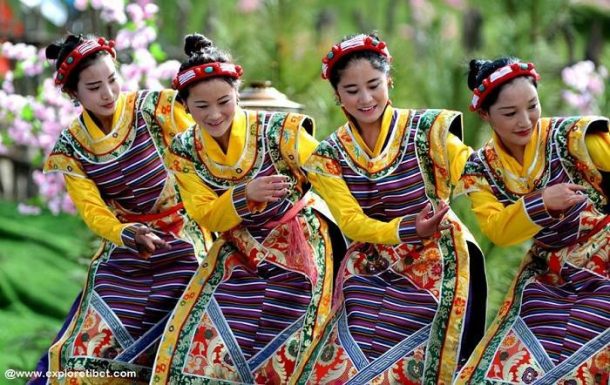Top Tibetan Festivals for 2019
Festivals in Tibet are an important part of the Tibetan calendar, as well as being a major part of the local people’s lives. Tibetans love festivals and celebrations, and in the Tibetan Buddhist calendar, there are more than twenty major festivals throughout the year, as well as several small local festivals. The Tibetan calendar lags around six weeks behind the western Gregorian calendar, and the first and most important festival of the year is the Tibetan New Year, known locally as Losar.

Tibetan women carry a “dou” of grain and the Buddhist scriptures
The Tibetan calendar starts with the Tibetan New Year, which usually falls in around the middle of February, though the date is never the same from one year to the next. Composed of either twelve or thirteen lunar months, the thirteenth month is only added every third year, which means that the New year date is constantly changing. The year count is also different, and the start of the modern Tibetan calendar was dated as being around 127 BC. The time of the first Tibetan king, Nyatri Tsenpo, which means that 2019 in Tibet is actually the year 2146 in the Tibetan Buddhist calendar.
Table of Contents
2019 Tibetan New Year Festival
Losar, or New Year, is the single most important festival in Tibet, and preparations for the celebrations begin weeks before the start of the New Year. The actual celebrations start on the first day of the Tibetan lunisolar calendar, which corresponds with February 5 in the Gregorian calendar used in the west. The celebrations of the New Year are held across all of the Tibet Autonomous Region, as well as in Tibetan areas of other Chinese provinces, mainly in Qinghai, Sichuan, Yunnan, and Gansu.
The festival normally lasts around 15 days, with the final day being another important festival in the Tibetan calendar, the Butter Lantern Festival. The first day of New Year is the time when people celebrate with their families, and after a trip to their temple to pray and give thanks, they eat breakfast together and spend the day at home playing games. On the third day, the family will change and replace all the prayer flags strewn over their house roof, setting up new ones to spread the blessings of the prayer flags across the world on the wind. The rest of the two weeks is spent in celebrations with family, friends, and relatives, until the final day, which celebrates Buddha’s miracle at Sravasti.
2019 Samye Cham Dance Festival
Famous for the amazing dances and performances of the monks in Tibet, the Cham Dance festival held at Samye Monastery in Lhoka Prefecture (Shannan) is one of the most important festivals in the Tibetan calendar. The oldest monastery in Tibet, constructed during the reign of the Tibetan king, Songtsen Gampo, the monastery hosts the Cham dance, which is performed by the monks for the local lay people. The dance consists of a variety of different performances, all of which have one similar strand running through them, the use of colorful and extravagant costumes and huge colorful masks. The masks are meant to drive fear into the demons of the plateau, and it is believed that the older the mask is, the more powerful its effect against the demons.

Tibetan Cham dance festival in Tibet
In 2019, the Cham Dance Festival at Samye Monastery falls on July 16 in the Gregorian calendar, which is the 4th day of the 6th month in the Tibetan calendar.
2019 Butter Lantern Festival
Falling on the 15th day of the first month of the year in the Tibetan calendar, which is February 19 in the Gregorian calendar, the Butter Lantern Festival marks the end of the New Year celebrations that have lasted for more than two weeks in Tibet. During the celebrations, Tibetans go to pray in their temples and monasteries, and in the evenings light lanterns and lamps made from yak butter as another form of prayer. The lanterns are all made by hand, usually by the people lighting them or local monks, and are sculpted into the shapes of animals, people, plants, and deities. The lanterns can attract people from neighboring areas, and some even stand as tall as a two-story house. One of the happiest times in Tibet, the festival celebrates the Buddha’s twin miracle at Sravasti, where he overcame his opponents and increased the number of followers of Buddhism.
2019 Tsongkhapa Butter Lamp Festival
Also known as the Ganden Ngachen Chenmo Festival, the Tsongkhapa Butter Lamp Festival is held on the 25th day of the 10th month of the Tibetan calendar, which is on December 21 in the western calendar. Another time when it is popular to light up the butter lamps on the Buddhist altars and temples, and in Lhasa even in the windows of people’s homes, the festival celebrates the “parinirvana” or death of the founder of the Gelug School of Tibetan Buddhism, Je Tsongkhapa.

Tibetan Butter Lamp Festival in Tibet
The festival is held in the Ganden Monastery in Lhasa, where Tsongkhapa died in 1419, the primary monastery of the Gelug School, and at the Jokhang Temple in Lhasa. The butter lamps are made a few days before the celebrations and kept cold to stop them from melting. When the night falls, the lamps are brought out and placed on altars and rooftops and are lit around the monastery and across the city. In the square in front of the Jokhang temple, thousands of people gather to see the lamps lit, accompanied by the sound of the suona, while a bowl of holy water is placed inside the temple, to reflect the light of the lamps.
2019 Shigatse New Year (Tsang Losar) Festival
Completely separate to the usual Losar festival that is held on the first day of the year in the Tibetan calendar, in Shigatse, they also celebrate the Tsang Losar, also known in the area as “Peasant’s Day”. Over 100 years ago, the people of this agricultural region of Tibet created their own calendar, which was more in line with the farming seasons of the Tsang area of ancient Tibet. Held on the first day of the 12th month in the Tibetan calendar, in 2019, this alternative Losar will be held on January 6 in the Gregorian calendar.

Local Folk Performance during New year in Tibet
The Shigatse celebrations are similar in form to those of the rest of Tibet during Losar, and the women of the Shigatse area keep their homes clean on the run-up to New Year to help keep in the good luck. One of e most iconic elements of the Tsang Losar is the ritual eating of guthuk, a kind of dough dumpling filled with different items, which often includes wool, stone, charcoal, or capsicums. Each of the fillings has meaning as to what the coming year will be like for the eater, and if the person eats a guthuk with wool in it, he is considered to be kind-hearted, while if the guthuk has capsicum, he is thought to be harsh-tempered. If he eats a gutu with charcoal, he is deemed to be vicious, while a gutu with white stones means he is unpopular and will be forced to drink wine as a punishment.
Food during the Tsang Losar is primarily dominated by mutton, a popular meat in the area where sheep farmers are plentiful. The dishes usually contain boiled mutton, dried mutton, or roast mutton, and the style of dishes has changed from those of eastern Tibet, and are richer and more sumptuous. However, you will still find the traditional guthuk being eaten on the days before the New Year.
Recent Posts
The Ultimate Guide to Tibet Tours, Travel, and Trekking Adventures
How to Explore Tibetan Culture
Exploring Lhasa:The Heart of Tibet
All Categories
- About Tibet
- book a Tibet tour
- Buddhism Practice
- Budget Tour
- China-Tibet Train
- Customized Tibet tour
- Historical Sites
- Hot Springs in Tibet
- News
- Photography in Tibet
- Tibet attraction
- Tibet Group Visa
- Tibet Motorcycle Tour
- Tibet Small Group Tours
- Tibet Tours and Tibetan Tour Guide
- Tibet Train
- Tibet Travel FAQs
- Tibet Travel Information
- Tibet Travel News
- Tibet Travel Permit Update
- Tibet Travel Prices Rises
- Tibet Trek
- Tibet Trekking Tour
- Tibet weather and climate
- Tibet Wildlife animals
- Tibet Winter Tour
- Tibetan Buddhism
- Tibetan Cultural Features
- Tibetan Culture and Poeple
- Tibetan Festivals
- What to see in Tibet



